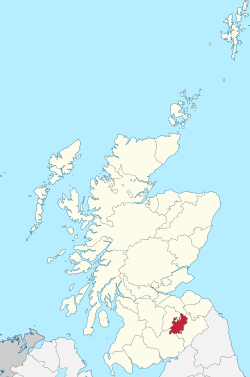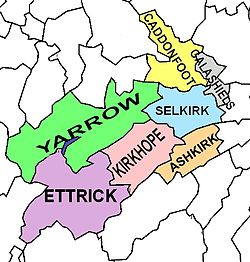Selkirkshire
Selkirk | |
|---|---|
 | |
| Country | Scotland |
| County town | Selkirk |
| Area | |
| • Total | 267 sq mi (692 km2) |
| Ranked 27th of 34 | |
| Chapman code | SEL |
Selkirkshire or the County of Selkirk (
Unlike many historic counties, Selkirkshire does not have its own lieutenancy area, but forms part of the Roxburgh, Ettrick and Lauderdale lieutenancy area.
History
In the 1st Century

In the Middle Ages the area that would become Selkirkshire formed part of the province of Tweeddale. The origins of the shire are obscure, but sometime around the twelfth century the area of Tweeddale was divided into two sheriffdoms: Peeblesshire to the north and Selkirkshire or Ettrick Forest to the south.[1] The first recorded sheriff of Selkirkshire was Andrew de Synton, who was appointed by William the Lion (d. 1214).[2] Synton in the parish of Ashkirk, just east of the village centre, was an enclave of Selkirkshire surrounded by Roxburghshire.[3]
Later, the


Selkirkshire County Council was created in 1890 under the
The county council was abolished in 1975 under the Local Government (Scotland) Act 1973, which reorganised local government in Scotland into upper-tier regions and lower-tier districts. Selkirkshire became part of the Borders region and part of the Ettrick and Lauderdale district.[14]
At the time of the local government reorganisation in 1975, the posts of
Folk ballads written of the county commemorate the Battle of Philiphaugh in 1645, the 'Dowie Dens' at Yarrow and Tibbie Shiels at St Mary's Loch.
Geography

Selkirkshire is a rural county, with a handful of small settlements set within hill and forest country. It forms part of the
Ettrick Forest
Ettrick Forest, also known as Selkirk and Traquair Forests, is a former royal forest in the Scottish Borders area of Scotland. It is a large area of moorland, south of Peebles, that once stretched from Ayr to Selkirk.
Keepers of the Forest
- Simon Fraser of Oliver (d. 1291)
- William Comyn of Kirkintilloch (d. 1291)
- Thomas de Burnham[17]
- Simon Fraser(1299–1306)
Transport
The Borders Railway connects Galashiels and Tweedbank with Edinburgh. Closed for many years, this line re-opened in 2015.[18] There are also buses to
Civil parishes and population
Selkirkshire was historically divided into civil parishes. There were originally nine parishes; Ashkirk, Bowside, Buccleuch (or Rankilburn), Duchoire, Ettrick, Kirkhope, Lindean, St Mary's (or St Mary of the Lowes) and Selkirk. There have been a number of changes since the medieval period:
- Caddonfoot was created in 1898 from the part of the parish of Stow of Wedale that lay within Selkirkshire.
- Galashiels was formed by the union of two ancient parishes, Bowside and Lindean.
- The parish of Rankilburn or Buccleuch was suppressed and united to Yarrow c. 1600, then transferred to Ettrick 1650.[19]
- The ancient parishes of Duchoire, St Mary's and Kirkhope were united to form the parish of Yarrow; Kirkhope was then separated from Yarrow in 1852.[20]
Population of the county by Civil Parish, according to the latest census (2011):[21][22]

| Civil Parish | Area (acres) |
Pop. 2011 |
|---|---|---|
| Ashkirk | 13,159 | 246 |
| Caddonfoot | 19,252 | 912 |
| Ettrick | 42,456 | 83 |
| Galashiels | 6,487 | 10,081 |
| Kirkhope | 22,734 | 263 |
| Selkirk | 17,854 | 6,401 |
| Yarrow | 48,851 | 281 |
| COUNTY | 170,793 | 18,267 |
The population of the towns in the county (in 2011):[23]
- Galashiels - 14,994 (of which 12,893 in Selkirkshire) [24]
- Selkirk - 5,784
Historical population of the county as returned by the census was as follows:[25]
- 1801: 5,889
- 1811: 6,637
- 1821: 6,833
- 1841: 7,990
- 1851: 9,809
- 1861: 10,449
- 1871: 19,651
- 1881: 26,346
- 1891: 28,068
- 1901: 23,356
- 1911: 24,601
- 1921: 22,607
- 1931: 22,711
- 1951: 21,729
- 1961: 21,055[26]
- 1971: 20,868 [27]
- 1981: 15,815 [28]
- 1991: 17,456[29]
- 2001: 17,757[30]
- 2011: 18,267[21]
Settlements


- Boleside
- Bowhill
- Broadmeadows
- Caddonfoot
- Clovenfords
- Ettrick
- Ettrickbridge
- Galashiels (partly in Roxburghshire prior to 1891)
- Philiphaugh
- Roberton
- Selkirk
- Yarrow
- Yarrowford
See also
- James Hogg
- List of places in the Scottish Borders
- List of places in Scotland
- Craik Forest
- Wauchope Forest
- List of forests in the United Kingdom
References
- ^ Chalmers, George (1810). "Of Selkirkshire". Caledonia. London: Cadell and Davies. p. 963. Retrieved 17 December 2022.
- ^ Encyclopædia Britannica 1911 edition, article on Selkirkshire.
- ^ Ordnance Survey One-inch to the mile maps of Scotland, 1st Edition, Jedburgh, pul. 1864
- ^ Dictionary of National Biography, 1885-1900, Volume 39, by Thomas Finlayson Henderson
- ^ Web site of History of Parliament Online http://www.historyofparliamentonline.org/volume/1690-1715/constituencies/selkirkshire retrieved Feb 2016
- ^ Peebles and Selkirk. Cambridge County Geographies. By George Pringle, Cambridge, 1914. p. 119
- ^ See http://www.walterscott.lib.ed.ac.uk/biography/chronology.html retrieved Feb 2016
- ^ "Selkirkshire Scottish County". A Vision of Britain through Time. GB Historical GIS / University of Portsmouth. Retrieved 17 December 2022.
- ^ "First Meeting of County Council". Southern Reporter. Selkirk. 20 February 1890. p. 3. Retrieved 17 December 2022.
- ^ "The budget rise in Selkirkshire". Southern Reporter. Selkirk. 14 September 1944. p. 6. Retrieved 17 December 2022.
...at a meeting of Selkirk County Council in the County Buildings, Selkirk, on Thursday evening...
- ^ Historic Environment Scotland. "Selkirk Sheriff Court and Justice of the Peace Court, including gatepiers, railings and boundary walls (Category B Listed Building) (LB43747)". Retrieved 17 December 2022.
- ^ "No. 19011". The Edinburgh Gazette. 23 July 1971. p. 576.
- ^ Historic Environment Scotland. "Bank Of Scotland, 6 Market Place, Selkirk (LB43793)". Retrieved 18 July 2021.
- ^ "Local Government (Scotland) Act 1973", legislation.gov.uk, The National Archives, 1973 c. 65, retrieved 22 November 2022
- ^ "The Lord-Lieutenants Order 1975", legislation.gov.uk, The National Archives, SI 1975/428, retrieved 27 November 2022
- ^ "The Lord-Lieutenants (Scotland) Order 1996", legislation.gov.uk, The National Archives, SI 1996/731, retrieved 16 December 2022
- William Blackwood and Sons, p. 310
- ^ Clinnick, Richard (16–29 September 2015). "The long wait is finally over as £296m Borders Railway opens". Rail. No. 783. pp. 6–7.
- ^ "Saints in Scottish Place-Names - Rankilburn, former parish, Ettrick". saintsplaces.gla.ac.uk. Retrieved 30 January 2021.
- ^ GENUKI. "Genuki: Yarrow, Selkirkshire". www.genuki.org.uk. Retrieved 30 January 2021.
- ^ a b Census of Scotland 2011, Table KS101SC – Usually Resident Population, publ. by National Records of Scotland. Web site http://www.scotlandscensus.gov.uk/ retrieved Feb 2016. See "Standard Outputs", Table KS101SC, Area type: Civil Parish 1930
- ^ Acreage from Gazetteer of Scotland, publ, by W & AK Johnston, Edinburgh, 1937. Figures for each parish, which are presented alphabetically with other places
- ^ Census of Scotland 2011, Table KS101SC – Usually Resident Population, publ. by National Records of Scotland. Web site http://www.scotlandscensus.gov.uk/ retrieved Oct 2016. See "Standard Outputs", Table KS101SC, Area type: Settlement
- ^ Excluding Tweedbank, which is in the Galashiels Settlement (according to the Census map with Settlement population) but is in the civil parish of Melrose. Census of Scotland 2011, Table KS101SC – Usually Resident Population, publ. by National Records of Scotland, for Tweedbank. Web site www.scotlandscensus.gov.uk - retrieved Oct 2016. See "Standard Outputs", Table KS101SC, Area type: Output Area. (See Tweedbank Wikipedia article).
- ^ Selkirkshire: Census Tables (Vision of Britain)
- ^ Third Statistical Account of Scotland, volume Peeblesshire & Selkirkshire, publ.1964, by J.P.B. Bulloch and J.M. Urquhart; chapter on Selkirkshire: Population
- ^ Census of Scotland, 1971
- ^ Census of Scotland, 1981 - SAS Table 6 Present Population (aggregate of the 7 civil parishes)
- ^ Scotland's Census 1991 - National Records of Scotland - Table KS101SC - Usual resident population (aggregate of the 7 civil parishes)
- ^ Census of Scotland 2001, Table CAS002 – Population by Age by Sex and Marital Status, publ. by National Records of Scotland. Web site http://www.scotlandscensus.gov.uk/ retrieved Feb 2016. See "Standard Outputs", Table CAS002, Area type: Civil Parish 1930; total for all Selkirkshire parishes
Further reading
The archeology and historic buildings of the county were documented in 1957 by the
External links
- "Selkirkshire" from A Topographical Dictionary of Scotland by Samuel Lewis, 1846 (British History Online)
- Entries on Selkirkshire from the Ordnance Gazetteer of Scotland by Frances Groome(1882-4) and the Gazetteer of the British Isles by John Bartholomew (1887) (Vision of Britain)
- EttrickForestArchers.co.uk
- RCAHMS record for Ettrick Forest or Selkirkshire
- SCRAN: Bowling champions in front of club house at Ettrick Forest Bowling Club, Selkirk
- The Borders Forest Trust
- Gazetteer for Scotland; Ettrick Forest
- Jstor: A newly discovered map of Ettrick Forest by Robert Gordon of Straloch
- The Ettrick Forest Tartan
- James Hogg, the Ettrick Shepherd
